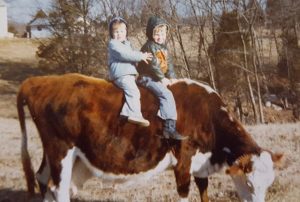By Crystal Kern | IEC Finance Director
I grew up on a self-sufficient farm in central Kentucky. We had a diverse garden with more plant varieties than I can recall along with several animals. Everything produced on the farm solely supported our family. If we had an abundance of produce, we would invite neighbors over to help themselves to what they needed. We spent most of our spare time canning and preserving our food rather than running to the grocery store. I didn’t think of these things as sustainability practices at the time. They were just how we did things. But, that’s exactly what they were.

We tended to the land and picked everything by hand, making due with just a tractor and a horse. We loaded our harvests into the corn crib ourselves and spent our days loading hay bales. Our grains were processed on-site with an old hammer mill. We then used these grains in a variety of ways. Some of the grains went to feed our cows, horses, chickens and goats. The rest were used in the kitchen. I still remember my Granny making the best whole wheat bread I’ve ever had in my life. Fresh churned butter from our cow, Bessie, made it even better!
The earth provided some of my most fond memories when simply left to do what it does best. There will always going to be indigenous and wild plants that grow on a farm, and we utilized them. We were able to hunt for wild morel mushrooms that were amazing fried in our homegrown cornmeal. We also had access to a variety of other things we could forage such as wild polk greens, wild blackberries, mulberries, persimmons, and sassafrass. All of these we utilized for a variety of food purposes, but sassafras has always been one of my favorites. When you harvest sassafras, you actually leave the tree in place and only dig up part of a root to process for tea-making. The tree would survive this every winter and allow us to go back again next January for harvest.
I took these things for granted at the time. As I get older, I realize how truly unique my life was growing up. These amazing practices are great for the environment, and I want my kids to be able to have the same appreciation of the bounty our earth offers—if we take good care of it—that I did growing up. So, when a 16-acre farm went up for sale near my current home, I felt compelled to take a risk and embrace my roots.
Inspired by my beginnings and the important work IEC and our partners are doing now around sustainable agriculture practices and local food, I decided it was a risk worth taking. Now, the farm I purchased is a work-in-progress. Our vision is growing and adapting as we go, and we are planning with the planet in mind. Originally, we had 10 acres of farm ground, 2 acres of pasture, and 4 acres for a home. Since purchasing the property two years ago, we built a home and cultivated a garden plot that takes up around a quarter of an acre. We have plans to expand our garden and have a large sweet corn patch.

In an effort to protect pollinators, I am excited about planting a perennial garden that will return every year. Next door to the perennial garden there will be a pollinator habitat and bird houses. You can head here for more information about why planting native pollinator plants is so important to protect bees, butterflies and other pollinators. We work on this issue at IEC and it’s great to put it into practice at home.
I also am hoping to plant a small orchard and vineyard by converting the 10 acres of commercial farmland by planting shade trees, fruit trees, berries, and wheat. Constructing a greenhouse on-site will allow me to provide tomatoes, greens, microgreens, radishes, and other smaller veggie varieties in the colder months.
I hope to capture all of the amazing things from my childhood farm and adapt them to fit my life now. Sharing this process with my children has made it even more special. Because this process is rooted in keeping the planet in mind and leaving this plot of land better than I found it, I have the opportunity to pass these cherished and much needed practices along to my children. In other words, this is how I’m reclaiming my heritage. It’s why I named my farm “Reclaimed Heritage” — because that is my true end goal.
It is gratifying to have the opportunity to share my experience converting this land into a more sustainable operation with not just my family and friends, but with people from around Illinois who are interested in protecting our environment and our precious natural areas. That’s part of why my work at the Illinois Environmental Council is so important to me. I carry with me the lessons and skills from my family farm growing up on my own farm now and in my role at IEC. I know how lucky I am to be able to work toward the goal of protecting the place we call home and the bounty if offers in a way that honors where I came from and the dreams I have for my family now.
“Whether we and our politicians know it or not, Nature is party to all our deals and decisions, and she has more votes, a longer memory, and a sterner sense of justice than we do.” ~ Wendell Berry

